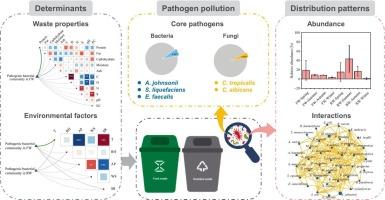北京市生活垃圾中病原微生物群落分布规律及影响因素分析
IF 7.1
2区 环境科学与生态学
Q1 ENGINEERING, ENVIRONMENTAL
引用次数: 0
摘要
城市生活垃圾为病原菌的传播和排放提供了适宜的环境,揭示病原菌的分布规律和影响因素对潜在风险的源头控制具有重要意义。本研究通过对北京市某高密度居住区的食物垃圾和剩余垃圾进行为期11个月的采集,分析了城市生活垃圾中病原菌和真菌的微生物群落。α多样性分析表明,餐厨垃圾与残厨垃圾微生物多样性差异显著;然而,韦塞拉菌和念珠菌的检出率一直很高。共检出43种病原菌和真菌。白色念珠菌、热带念珠菌、粪肠球菌、液化沙雷菌和约氏不动杆菌是核心致病菌,它们的相对丰度和发生频率较高。虽然温暖的季节似乎有利于病原体的积累,但群落和季节之间没有发现显著的相关性。不同垃圾类型的致病微生物群落差异显著,残渣垃圾中细菌病原体的相对丰度高于食物垃圾,真菌病原体的相对丰度则相反。废物的性质,包括蛋白质、碳、氢含量和电导率,对形成病原微生物的多样性至关重要,环境条件,包括温度、大气压力和相对湿度也有影响。研究结果为家庭生活垃圾中病原菌的分布规律及影响因素分析提供了科学依据,可为废物管理中职业健康风险的控制和进一步评价提供依据。本文章由计算机程序翻译,如有差异,请以英文原文为准。

Distribution patterns and influencing factors of pathogenic microbial communities in household municipal solid waste: A case in Beijing, China
Household municipal solid waste (MSW) provides a suitable environment for the propagation and emission of pathogens, and revealing their distribution patterns and influencing factors is important for source control of the potential risks. This study analyzed the microbial communities of pathogenic bacteria and fungi in MSW, by collecting both food waste and residual waste samples from a high-density residential area in Beijing for 11 months. Alpha diversity analysis indicated that the microbial diversity differed significantly between food waste and residual waste; however, Weissella and Candida were consistently detected at high proportions. In total, 43 pathogenic bacterial and fungal species each were detected. Candida albicans, Candida tropicalis, Enterococcus faecalis, Serratia liquefaciens, and Acinetobacter johnsonii were identified as core pathogens with high relative abundances and occurrence frequencies. While warmer seasons appeared to favor the accumulation of pathogens, no significant correlation between communities and seasons was found. Pathogenic microbial communities differed significantly among waste types, with relative abundances of bacterial pathogens being higher in residual waste than in food waste, and vice versa for fungal pathogens. Waste properties, including protein, carbon, and hydrogen contents and electrical conductivity are crucial in shaping the pathogenic microbial diversity, and environmental conditions including temperature, atmospheric pressure, and relative humidity also contribute. The findings in distribution patterns and influencing factors of pathogens in household MSW provide a scientific basis for the source control and further assessment of occupational health risks in waste management.
求助全文
通过发布文献求助,成功后即可免费获取论文全文。
去求助
来源期刊

Waste management
环境科学-工程:环境
CiteScore
15.60
自引率
6.20%
发文量
492
审稿时长
39 days
期刊介绍:
Waste Management is devoted to the presentation and discussion of information on solid wastes,it covers the entire lifecycle of solid. wastes.
Scope:
Addresses solid wastes in both industrialized and economically developing countries
Covers various types of solid wastes, including:
Municipal (e.g., residential, institutional, commercial, light industrial)
Agricultural
Special (e.g., C and D, healthcare, household hazardous wastes, sewage sludge)
 求助内容:
求助内容: 应助结果提醒方式:
应助结果提醒方式:


